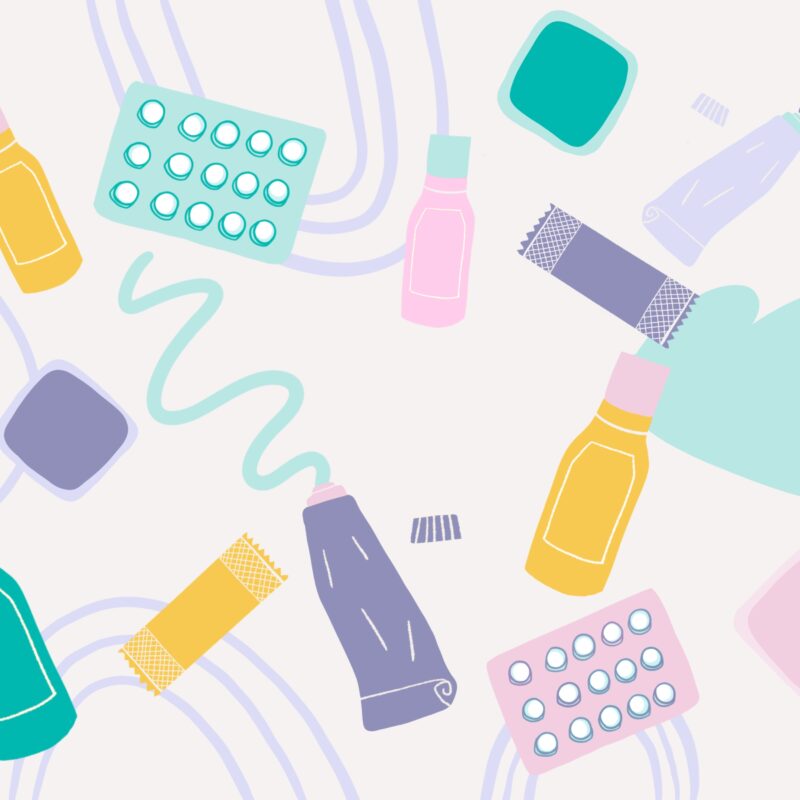Oestrogen in patches, gels or sprays
A guide to understanding the different ways of taking oestradiol (oestrogen) so you can decide what’s best for you
- Oestradiol is the main part of HRT and is available in different formats
- Transdermal oestradiol – through a patch, gel or spray – is generally recommended as it’s released directly into your bloodstream
- Doses can be tailored through patches, gels or sprays
Oestradiol (oestrogen) is the main hormone in hormone replacement therapy (HRT). Levels of oestradiol fluctuate during perimenopause then become low during menopause and remain consistently low. Lower levels of hormones (oestradiol, progesterone and testosterone) can cause perimenopausal and menopausal symptoms, plus are associated with an increased risk of health conditions.
RELATED: The power of 3: the role of oestrogen, progesterone and testosterone
The oestradiol in HRT can be given as either a tablet or as a transdermal preparation, this means oestradiol is delivered through the skin as a patch, gel or spray. Transdermal options are natural (body identical) – they are derived from yam plants or soy and have the same chemical structure as your body’s own oestradiol. Body identical HRT is the type of HRT recommended by the National Institute of Health and Care Excellence (NICE) guidelines [1].
RELATED: Body identical hormones
What are the benefits of transdermal oestrogen?
As well as being body identical, oestradiol in a patch, gel or spray is usually the preferred method of application for numerous reasons:
- It is systemic HRT, which means oestradiol is released directly into your bloodstream and does not have to be digested or metabolised. It can travel through your body where it can relieve a wide range of symptoms as well as improving the function of various organs, tissues and cells in your body.
- There is no increased risk of clot or stroke using transdermal oestradiol.
- Taking oestrogen as a tablet leads to the liver clotting factors being activated, so there is a small increased risk of clot and stroke in women who take oestrogen in tablet form.
- Transdermal oestradiol can be used by women with migraines. Migraines can often become more severe and more frequent in perimenopause and menopause – HRT usually improves migraine symptoms. As there is a small increased risk of stroke in some women who have migraine, it is safer and advisable to take oestradiol as a patch, gel or spray.
- Transdermal oestradiol does not worsen libido. Taking oestrogen as a tablet, however, can increase levels of Sex Hormone Binding Globulin (SHBG), which binds to testosterone – this effect can then reduce amount of testosterone and then result in a lower libido. Taking oestradiol in a patch, gel or spray does not have this effect.
- The dose of transdermal oestradiol can be adjusted easily. It is very common that younger women need to have higher doses of oestradiol than older women [2]. Many women find that their oestradiol requirements change with time. It is very easy to either adjust the dose of the patch, or the amount of gel or spray used.
Once you have decided to take transdermal oestradiol, you can choose which preparation might suit your best.
How do I use oestrogen patches?
Oestrogen (oestradiol) patches should be stuck onto your skin below your waist. Most women stick them to the skin on their bottom or upper thigh.
They are usually changed twice a week - for example, if you put one on a Monday then you change it on a Thursday.
The patches usually stick on well and stay in place in the shower, bath or when exercising. A plaster mark sometimes occurs when they are removed. Using baby oil or eye makeup remover and a dry flannel is effective at removing these marks.
RELATED: How to apply HRT patches
How do I use oestrogen gel?
Oestrogen (oestradiol) gel usually comes in a pump-action bottle called a ‘pump pack’. It also comes in small sachets. The gel should be applied to the outer part of your arm, from your shoulder to your elbow, and to your inner thigh. It can also be rubbed on other sites of your body (although not advisable on your breasts).
Despite what the leaflet insert says, it is preferable to rub the gel into the skin as this aids absorption. The gel usually gets absorbed into your body very easily. You should avoid using other products on your skin for up to an hour after you have rubbed in the gel and ensure you wash your hands well after applying it.
RELATED: How to apply Oestrogel
Your doctor will recommend how many pumps of the gel or how many sachets you need to use. Most women use between two and four pumps of gel each day, but the actual amount varies between women. Some women use the gel in the morning, others in the evening and some women use it in both the morning and evening.
RELATED: Oestrogel and Sandrena
How do I use oestrogen spray?
Oestrogen (oestradiol) spray should be applied to clean, dry, healthy skin of your outer arm or inner thigh, in areas that do not overlap. Absorption may be lower if you apply it to your abdomen, and oestrogen in patches, gels or sprays should not be applied to your breasts.
Your doctor will recommend how many sprays to use and how often.
You can get dressed a few minutes after applying the spray when your skin is dry but you should leave around 60 minutes before bathing or washing. There is no need to rub the spray in.
RELATED: Lenzetto: Oestrogen-only spray
What else do I need to consider?
If you still have your uterus (womb), you will also need to take progesterone to protect the lining of your womb. This is because taking oestrogen by itself can increase the thickness of the lining of your womb – taking progesterone reduces this effect. Progesterone is usually given as an oral capsule (known as micronised progesterone), but it can also be given in the form of a coil inserted into your womb (uterus). The Mirena coil can be beneficial to women who also need contraception.
Women who have had a hysterectomy can still often benefit from taking progesterone as it has many beneficial effects throughout your body.
RELATED: Utrogestan (micronised progesterone) explained
Remember, there are many different preparations of HRT and if one type does not suit you, it is very likely that another type or dose will. Talk to your healthcare professional to help determine the best option for you.
RELATED: What to do if HRT seems to have stopped working for you
References
- National Institute for Health and Care Excellence (NICE), Menopause: identification and management (NG23)
- Baber R. J., Panay N., & Fenton A. (2016) ‘IMS Recommendations on women’s midlife health and menopause hormone therapy’, Climacteric, 19(2), pp109–150. https://doi.org/10.3109/13697137.2015.1129166

![How to apply Oestrogen Spray [Video]](https://balance-menopause.com/uploads/2021/12/HRT_V2-5-scaled-e1640341793806-800x640.jpg)
![What is HRT? [with sign language]](https://balance-menopause.com/uploads/2021/12/HRT_V2-3-scaled-e1640341708967-800x800.jpg)


